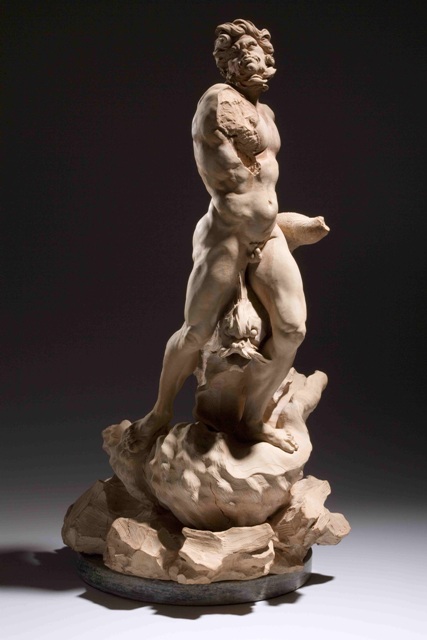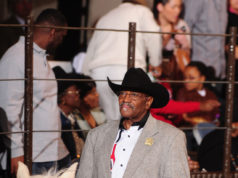There’s this really ridiculous, rarely fun game I play called Museum Swap, in which I try to picture an exhibit at one of our major museums –– the Carter, Kimbell, or Modern –– in either one or both of the other two. Say you’re cruising through the Modern, and you come across a Motherwell. You could totally also imagine it at the Carter, right, but at the Kimbell? Actuallyyy? Maaaybeee? A Donald Judd, on the other hand, or a Warhol? Nope, only at the Modern, although –– although –– if you’ve been in town long enough, you could probably imagine the Carter or Kimbell whipping up a context, or an aesthetic theme, if you will, into which a Judd or a Warhol would actually fit.
Anyway, I try not to play Museum Swap every time I go to the Cultural District, but …
The Kimbell’s Bernini: Sculpting in Clay –– whose end date has been extended to May 5 –– is, for a Museum Swapper, a sort of bittersweet experience. All of these amazing terracotta studies (the real Berninis are in marble and bronze –– and in Italy) sit trapped in this fractured time and place (the post-historical). Most of what passes for public figurative sculpture today is hyper-realistic and mostly dour, and most of what passes for baroque-inspired sculpture is patently garish (growling, slinking panthers, lions with a thing for support columns, fat angels). I’ve got at least 99 problems with contemporary art, the biggest being that some of it requires more analytical skill than technical skill, but there is a lot to love, including mucho faux-baroque stuff (John Currin, Matthew Barney, former Modern exhibitors Kehinde Wiley and Ron Mueck).
Walking through the Kimbell, surrounded by Bernini’s wildly imaginative and outrageously gorgeous studies for (mostly) figures and fountains, I began to fictionalize a contemporary art star, a guy who produces studies for wildly imaginative public sculptures which are imbued with both a master’s touch and a prankster’s wry sensibility. Could you imagine if his entire persona was fictional, with a fake name and a made-up backstory and body of work? Maybe in his exhibit (at the Modern), you would come across a pedestal containing a terracotta study of Ray Lewis wearing only a lyrical cloak, sitting on the severed heads of Dracula and a great white shark, and clasping his hands heavenward in prayer, his eyes widening rapturously. The wall text may read, “Model for ‘The Ecstasy of St. Ray’: Throughout the artist’s life, he has attempted to capture the unbridled egomania of the West’s successful athletes, from elementary school all the way up through the pros, using inventive posing techniques to harness the natural lighting and to accentuate the subjects’ immeasurable self-love.”
Even back down on terra firma, in the here and now, Bernini: Sculpting in Clay is a marvel. If you’ve never been to Italy and have never stood in front of a Bernini, you –– like a vast majority of us Fort Worthians –– are reduced to straining to wrap your mere mortal head around the fact that not only do most of the Berninis on display exist in marble and bronze but that they exist in marble and bronze and are larger than life and totally flippin’ awesome.
When the aliens finally come to destroy us, they too will marvel that the same species that murders and maims itself every minute of every day is the same species that creates stuff like “Cathedra Petri,” Bernini’s gilt bronze reliquary of the wooden throne alleged to have been sat upon by St. Peter, Jesus’ right-hand man and the first pope. Though not nearly as glorious as the real thing (I’ve seen photos), the terracotta model is so symmetrical and so richly detailed as to be machine-made. In fact, Bernini’s studies at the Kimbell are so magnificent –– they’re realistically based but fantastically dreamy –– you’ll wanna board the next plane to England and slap Damien Hirst. Check out Bernini’s “Model for the Fountain of the Moor.” In clay and in only about two-and-a-half feet, the Italian master manages to say more than Hirst and his ilk combined over the past half-century. As the moor stands there armless but planted on tree-trunk legs, he with his rippling musculature, his scrunched-up face probing the sky, and, of course, his flowing/pompadour’d hair is brilliantly realized. (In real-life, the moor –– probably originally meant to be Neptune –– is standing on a conch shell, wrestling a dolphin.)
That’s what I mean by fantastical: Most of his figures are depicted in stylized action (yes, even if that action is prayer). Bernini is probably best known for his fountains, and for good reason –– he wasn’t just a sculptor; he was perhaps the world’s first landscape architect. Figurative statuary was only one element of the elaborate tableaux he designed and erected in cityscapes, including his most famous, Piazza Navona, the site of the moor. Back in 17th-century Europe, fountains were big deals, commissioned by patrons to celebrate both the successful channeling of sources of water into cities and the patrons themselves. Pope Innocent X was so ensorcelled by Bernini’s Four Rivers Fountain that he commissioned another to the south end of the piazza. The pope said no to Bernini’s first two proposals but yes to his third and final one. The winning study? “Model for the Fountain of the Moor.”
Bernini, the father of 11, was also a holy roller. Though his studies may lead you to believe otherwise, his religious statuary is his best. It’s his most detailed and most impassioned. Over the course of his long career, he completed numerous projects for Saint Peter’s Basilica, including “Cathedra Petri” (the visual and religious climax of the nave) and “Charity with her Four Children,” whose narrative, frenetic study is of a beautiful, strong young woman with soft “skin,” wearing an expression somewhere between anger and bemusement, and with fine, sharply pleated drapery as her garments, trying to wrangle three naked toddlers while feeding one from her left breast.
The studies helped Bernini visualize his sculptures, give his workers points of reference, and, in some cases, win commissions. Organized by the Metropolitan Museum of Art and the Kimbell, Bernini: Sculpting in Clay features approximately 40 studies and 30 drawings. The first to “retrace Bernini’s unparalleled approach to sculptural design and his impact on the fabric of Baroque Rome,” the Kimbell said, Bernini: Sculpting in Clay is a sumptuous experience. The wall text is almost always illuminating and often doesn’t repeat itself, and the power of the studies is ramped up by the massive black-and-white photographs of the actual statues which span the gallery walls. Tickets are $6-16.
And with its squiggly black lines and mercurialness, “Study for Sea Deity” looks like something you’d see at the Carter. Or the Modern.











